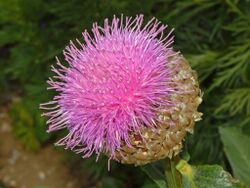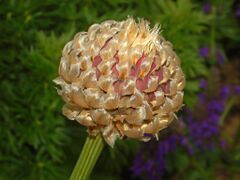Biology:Leuzea rhapontica subsp. heleniifolia
| Leuzea rhapontica subsp. heleniifolia | |
|---|---|

| |
| Flower | |
| Scientific classification | |
| Kingdom: | Plantae |
| Clade: | Tracheophytes |
| Clade: | Angiosperms |
| Clade: | Eudicots |
| Clade: | Asterids |
| Order: | Asterales |
| Family: | Asteraceae |
| Genus: | Leuzea |
| Species: | |
| Subspecies: | L. r. subsp. heleniifolia
|
| Trinomial name | |
| Leuzea rhapontica subsp. heleniifolia (Gren. & Godr.) Holub[1]
| |
| Synonyms[1] | |
| |
Leuzea rhapontica subsp. heleniifolia, synonym Rhaponticum heleniifolium, is a flowering plant in the genus Leuzea of the family Asteraceae.[1]
Description
The biological form of Leuzea rhapontica subsp. heleniifolia is hemicryptophyte scapose,[2] as its overwintering buds are situated just below the soil surface and the floral axis is more or less erect with a few leaves.
Leuzea rhapontica subsp. heleniifolia reaches on average 50–150 centimetres (20–59 in) in height.[2] The strong, thick, upright stem is quite leafy and hairy and usually has only one inflorescence. The leaves are green, while its underside is white-tomentose.[2] Regarding the morphology of leaf blades, this species is quite polymorphic. The basal leaves are usually lanceolate or elliptical and petiolated.[2] The flower heads are pink to purple, spherical and very large (about 6–10 centimetres (2.4–3.9 in) in diameter).[2] The bracts are brownish and membranous. The flowering period extends from June to August. The flowers are hermaphroditic and are pollinated by insects. The fruits are brown achenes.
Distribution
This quite rare plant occurs in Italy, France , Switzerland , and Austria.[1][3]
Habitat
It grows in western Alps in sub-alpine and alpine meadows and stony slopes. This plant prefers calcareous soils, at altitudes from 750 to 2500 meters.[2]
Gallery
References
- ↑ 1.0 1.1 1.2 1.3 "Leuzea rhapontica subsp. heleniifolia (Gren. & Godr.) Holub". Plants of the World Online. Royal Botanic Gardens, Kew. http://www.plantsoftheworldonline.org/taxon/urn:lsid:ipni.org:names:877620-1.
- ↑ 2.0 2.1 2.2 2.3 2.4 2.5 Pignatti S. - Flora d'Italia – Edagricole – 1982. Vol. III, pag. 173
- ↑ Distribution and Synonyms in Compositae
- Josef Holub - Contribution to the taxonomy and nomenclature of Leuzea DC. and Rhaponticum auct - Folia Geobotanica - Vol. 1 / 1966 - Vol. 46 / 2011
External links
| Wikimedia Commons has media related to Leuzea rhapontica subsp. heleniifolia. |
Wikidata ☰ {{{from}}} entry





